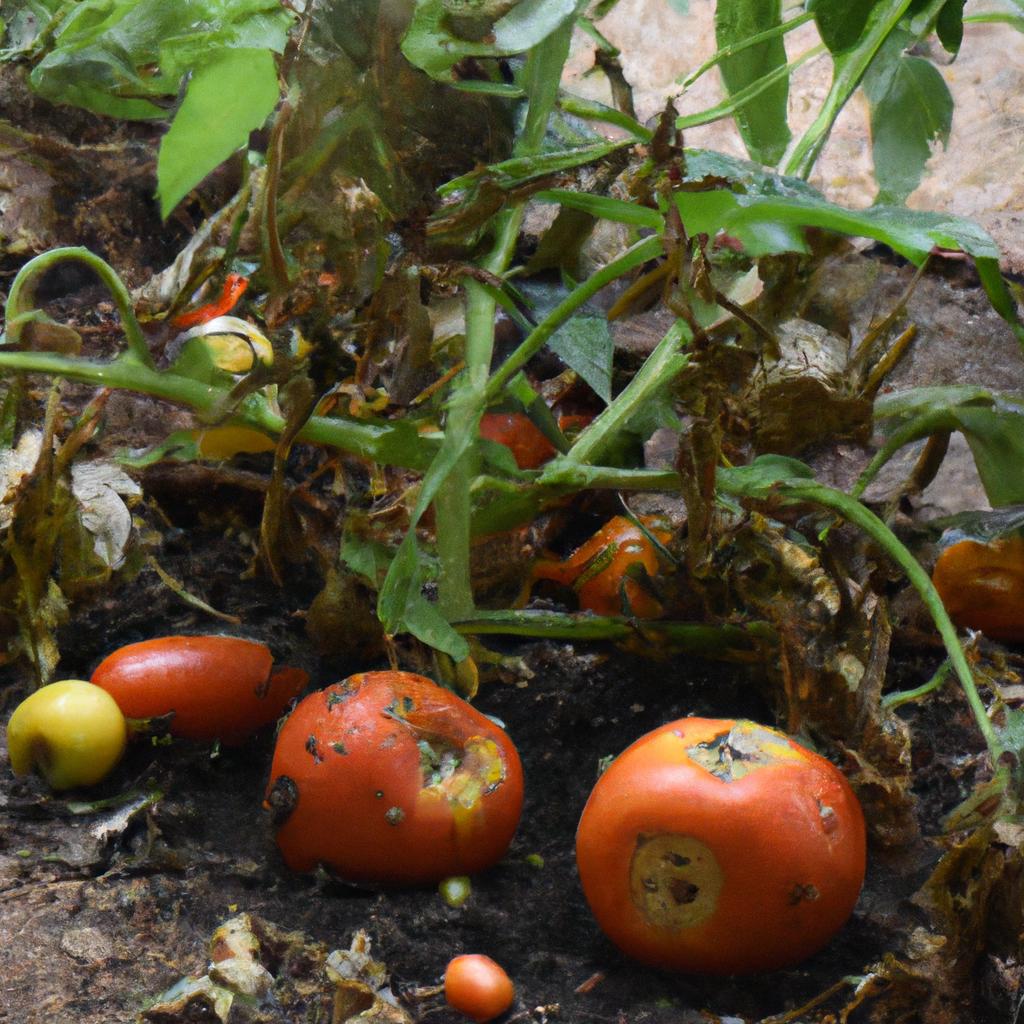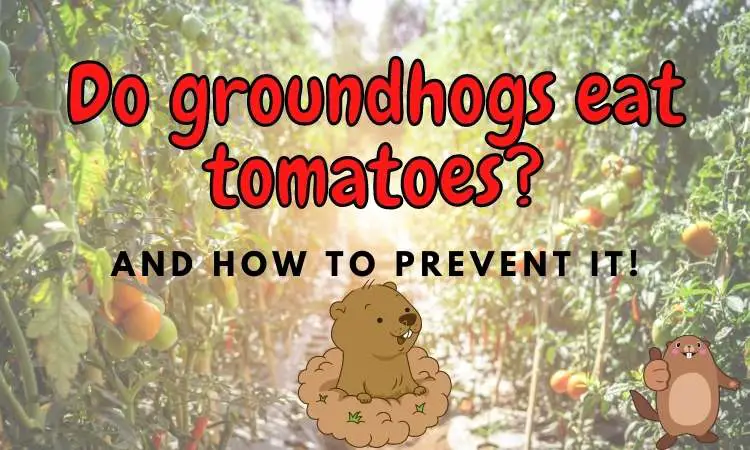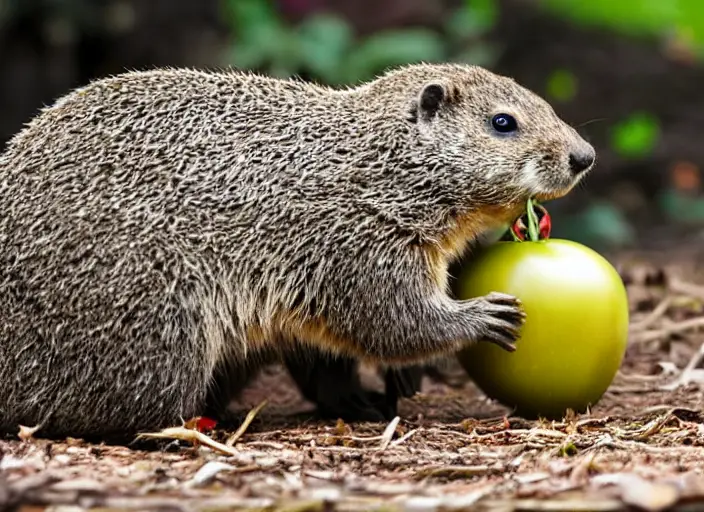As a passionate gardener, I always have my eyes on my precious tomato plants. They are my pride and joy, and I take care of them as if they were my own children.
However, I have been hearing some rumours about groundhogs and their love for tomato plants – is it tru?
Yes! Groundhogs do eat tomato plants. They are known to consume various parts of the plant, including leaves, stems, and fruits.
To protect your tomato plants from groundhogs, consider using fencing, repellents, or live traps to deter or remove them from your garden area. Regularly monitor your plants for signs of groundhog activity and take appropriate action to minimize damage.

Groundhogs and Tomatoes
Groundhogs are herbivores, which means that they only eat plants.
However, they are not selective in their food choices and will eat almost anything that they can find.
This includes fruits, vegetables, flowers, and even some types of trees.
Unfortunately, tomato plants are not an exception.
Groundhogs usually feed on tomato plants during the summer months when the plants are producing ripe fruits.

They will climb over fences and walls to get to the plants and will even dig under them to access the roots.
They are known to eat the fruits, leaves, and stems of the tomato plant, which can cause significant damage.
How and when Groundhogs Eat Tomato Plants
Groundhogs are diurnal animals, which means that they are active during the day. They usually feed in the early morning or late afternoon and will eat for several hours at a time.

They are known to be voracious eaters and can consume up to a pound of food per day.
When it comes to tomato plants, groundhogs will usually start by eating the ripe fruits first. They will then move on to the leaves and stems, which they will chew and gnaw on until there is nothing left.
They will also eat the flowers of the plant if they are available.
Why Groundhogs Eat Tomato Plants
Groundhogs are opportunistic feeders and will eat whatever is available to them. However, there are several reasons why they might be attracted to tomato plants specifically.
Firstly, tomato plants are typically grown in open areas, making them easy to access for groundhogs. Secondly, tomato plants are often planted in gardens, which are usually located close to human settlements.
This means that groundhogs have easy access to food without having to travel far. Finally, tomato plants are high in sugar content, which makes them attractive to groundhogs.
Implications for Backyard Owners
If you are a backyard owner and you have tomato plants growing in your garden, you should be aware of the potential risk of groundhog damage. The best way to protect your plants is to install a fence around your garden.
The fence should be at least three feet high and should be buried at least six inches in the ground to prevent groundhogs from digging underneath.
You can also try using repellents, such as garlic or hot pepper spray, to deter groundhogs from your garden.
However, these methods are not always effective, and you may need to resort to trapping and removing the animals if they become a persistent problem.
Other Animals That Might Eat Tomato Plants
While groundhogs are a known threat to tomato plants, they are not the only animals that might be interested in eating them. Other common garden pests include deer, rabbits, squirrels, and birds.
These animals can also cause significant damage to your tomato plants and should be taken into consideration when planning your garden.
How To Keep Groundhogs Out Of Your Yard!
There are several things that can be done to prevent groundhogs from digging and eating stuff in your backyard. I will list some of the strategies below.
Also, see my recent post if you want a full list of my favorite methods to keep groundhogs and gophers away!
1. Using ultrasonic sound
Groundhogs, like other bigger mammals that may invade your garden, tend to have very good hearing. This means that loud or consistent noises will scare them away or at least shorten their visits.
Check out my full buying guide for these ingenious ultrasonic repeller devices here!
One of my favorite technologies to keep pests away from my backyard is these cool solar-powered ultrasonic sound emitters that you can buy right from Amazon! In my experience, they really work, and the solar panels on top save you the time and money of changing batteries all the time.
They will also work against other rodents like gophers, mice, and rats!
2. Sprinkling natural repellents
Groundhogs may be scared off by using natural scents such as coyote urine or predator scents.
They may also cause them to leave if there is a combination of sounds being played from a radio. The sounds include the sound of barking dogs and coyotes.
You can sprinkle dog hair, cayenne pepper or strong enteric oils and other natural repellents around the garden to keep the groundhogs away.
See my complete list of humane ways to keep groundhogs away from your yard for more tips and tricks!
3. Fencing around the garden
You can also fence around your garden to keep groundhogs from entering the garden. It should be at least 3 feet deep and have a double row of fencing.
Groundhogs are good diggers so it has to go underground or they may find a way into the garden even with the fences in place!
4. Using live traps
You can use a live trap to capture groundhogs and move them to another area. Live trapping is currently the most humane way of groundhog control. Once you have removed all groundhogs from an area, it is important to ensure that they do not come back by using fencing or other barriers to block access.
You can also just buy a live trap, as the sturdy metal ones shown here:
To lure the groundhogs in, you can use one of the numerous favorite foods of groundhogs or an optimized extra attractive formula like this one to make the catch even quicker!
5. Using natural pesticides
There are pesticides or rodent toxins that can be used to kill groundhogs on your property. These may also affect other animals in the area so it is important to ensure that they are only sprayed on the targeted plants.
I do not recommend these, as I prefer more humane ways as described here. Also, anything that kills an animal will also harm humans to some degree, so go for a repellant rather than a toxin if you go the chemical route!
6. Using Scarecrows
You can use a scarecrow in your garden to keep groundhogs away. Groundhogs are afraid of novelty so time-sensitive or motion-activated scarecrows may also be effective in keeping them out of the garden.
7. Using Lights
Groundhogs are not strictly nocturnal animals but they are most active at low light so they do avoid areas with bright lights.
Motion-activated lights, sounds, and sprinklers may help prevent groundhogs from entering your yard.
Any blinking light will confuse and scare away groundhogs from your yard, especially if they are motion activated and sudden!
8. Motion-activated sprinklers
Like most animals, groundhogs hate surprises, and they will run away if suddenly sprayed with water. I like this solution because it is humane, simple, effective, and does not require much time to set up.
The Havahart 5277 is a motion-activated sprinkler that is activated by the movement of animals up to 25 feet away and sprays them with a harmless water jet, frightening them off and keeping them at bay.
The included metal stake makes it easy to install in your garden, and the sprinkler can be rotated 180 degrees for maximum coverage.
In conclusion, groundhogs do eat tomato plants, and they can cause significant damage if left unchecked.
As a gardener, it is essential to be aware of the potential risks and take steps to protect your plants.
With the right precautions, you can enjoy a bountiful tomato harvest without having to worry about pesky groundhogs ruining your hard work.
















